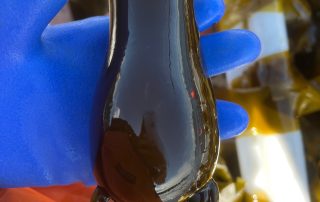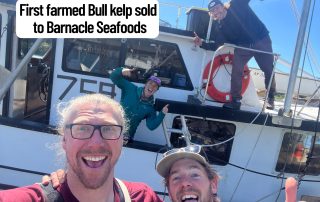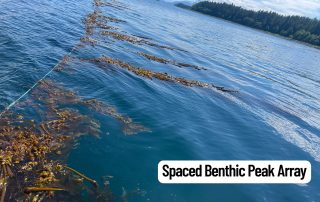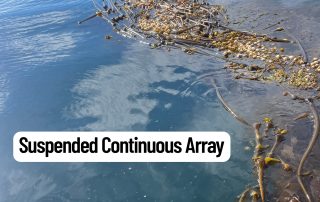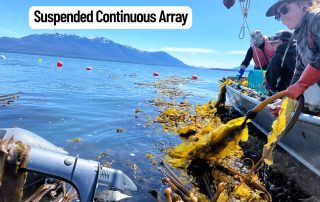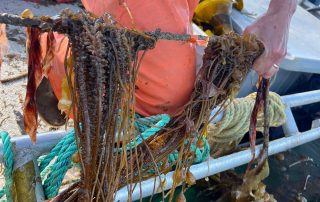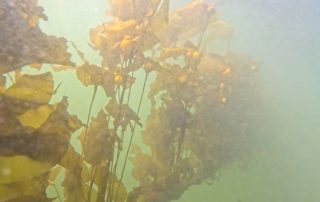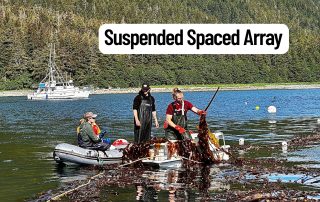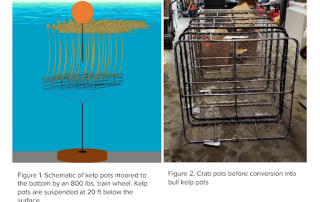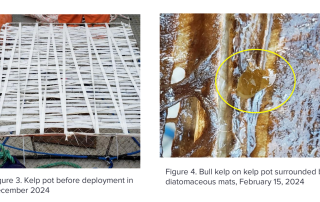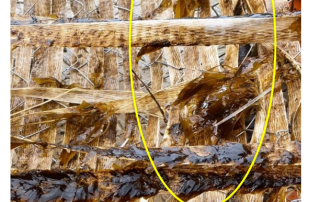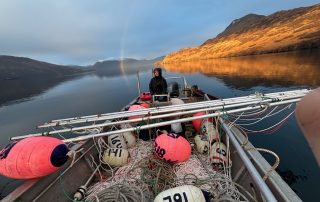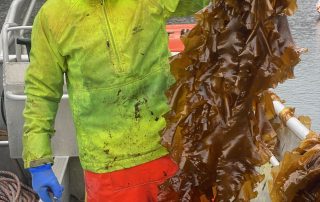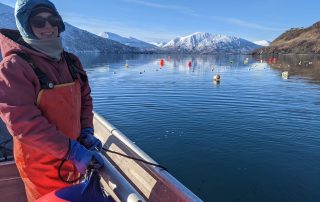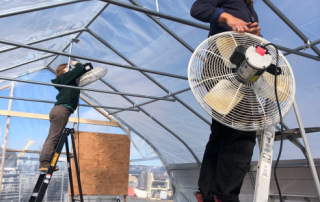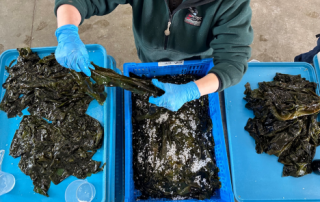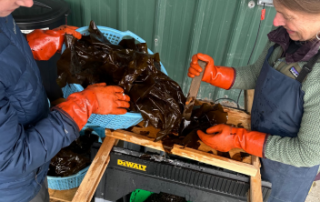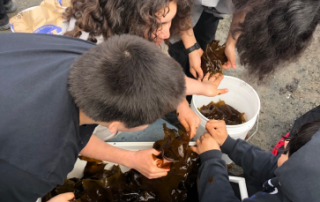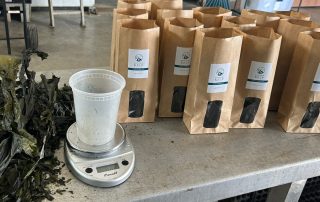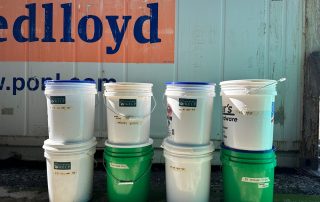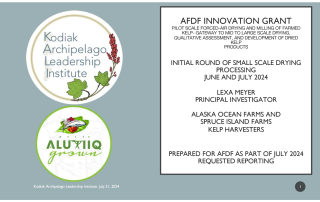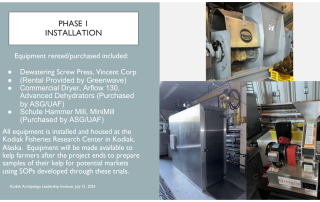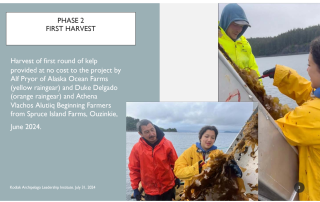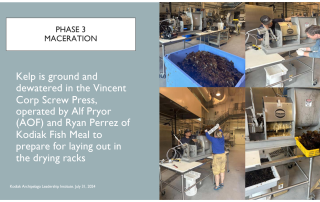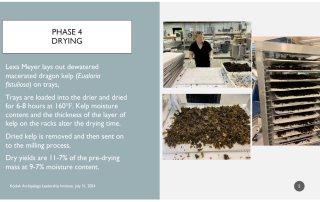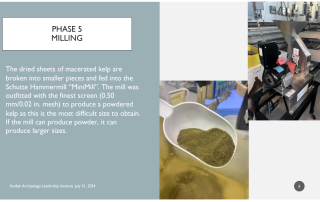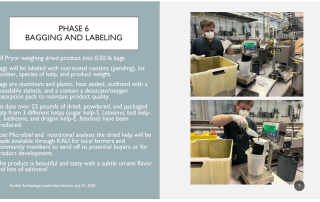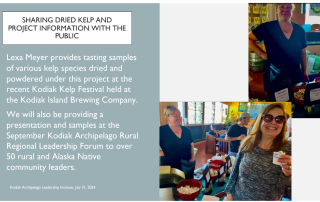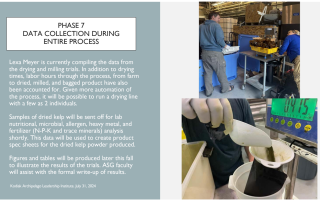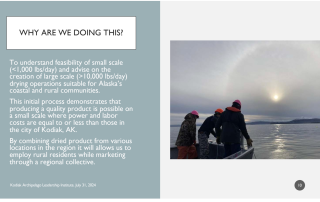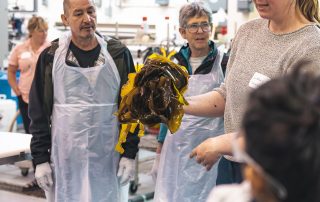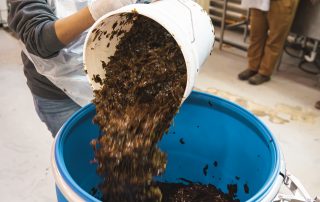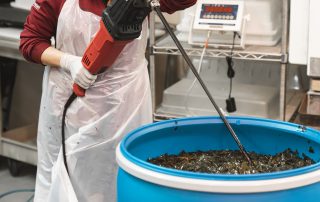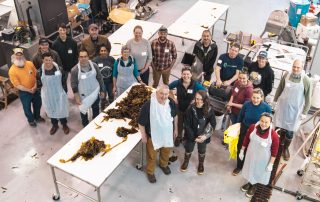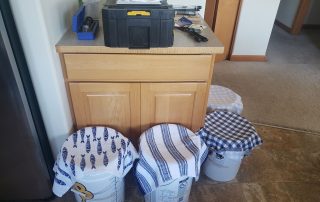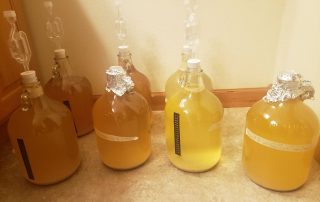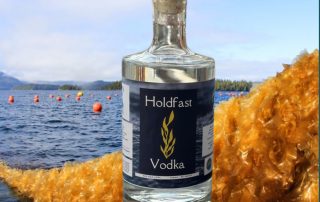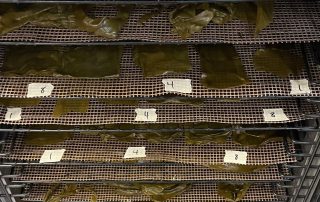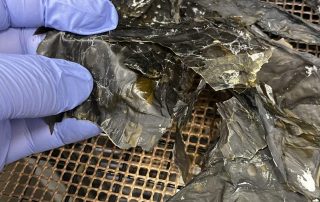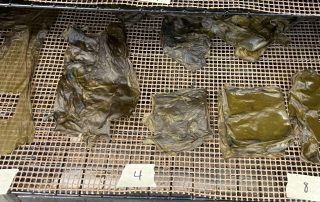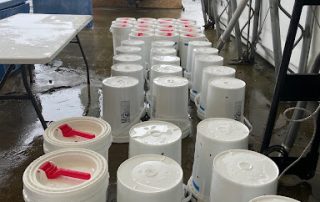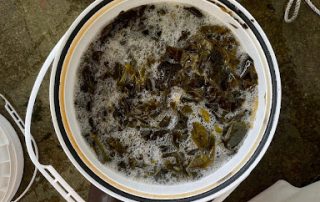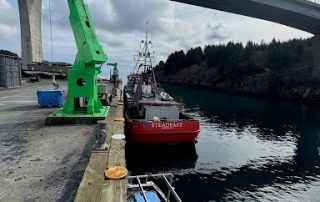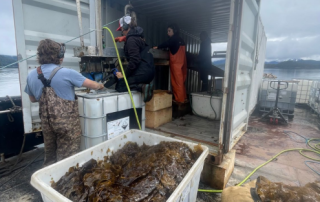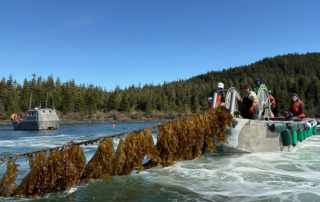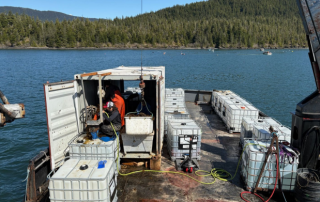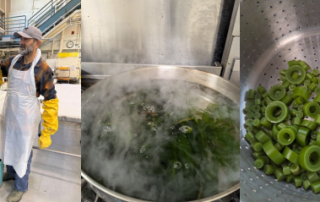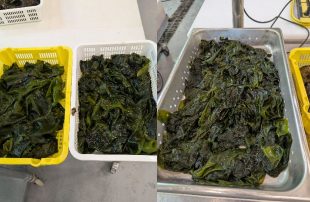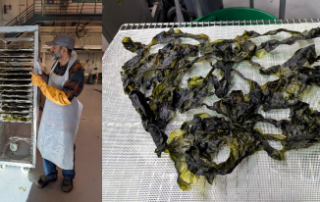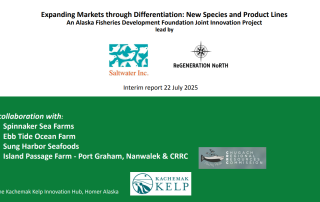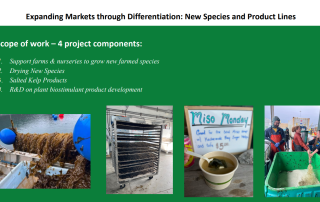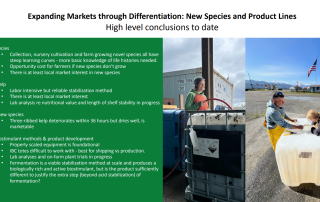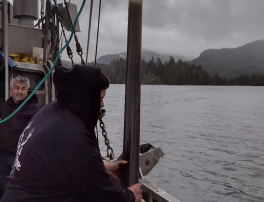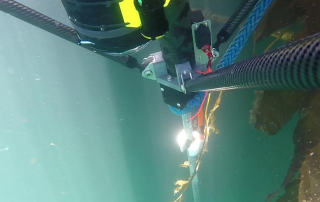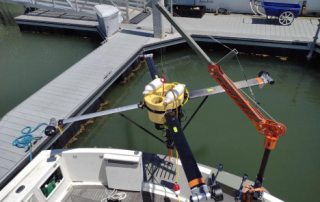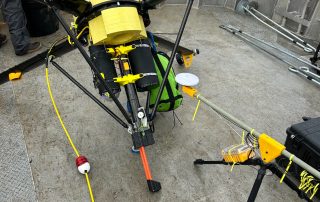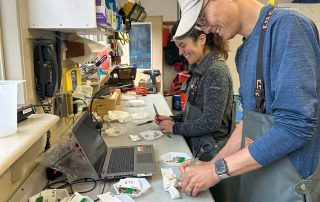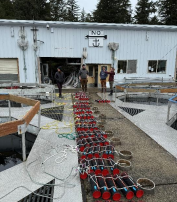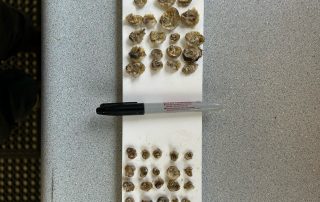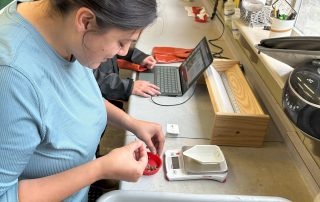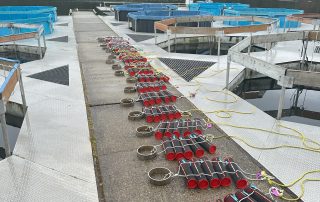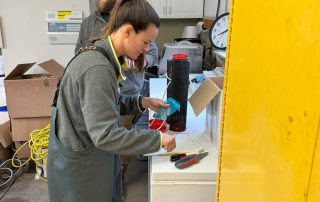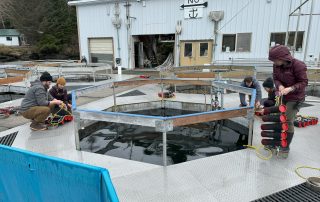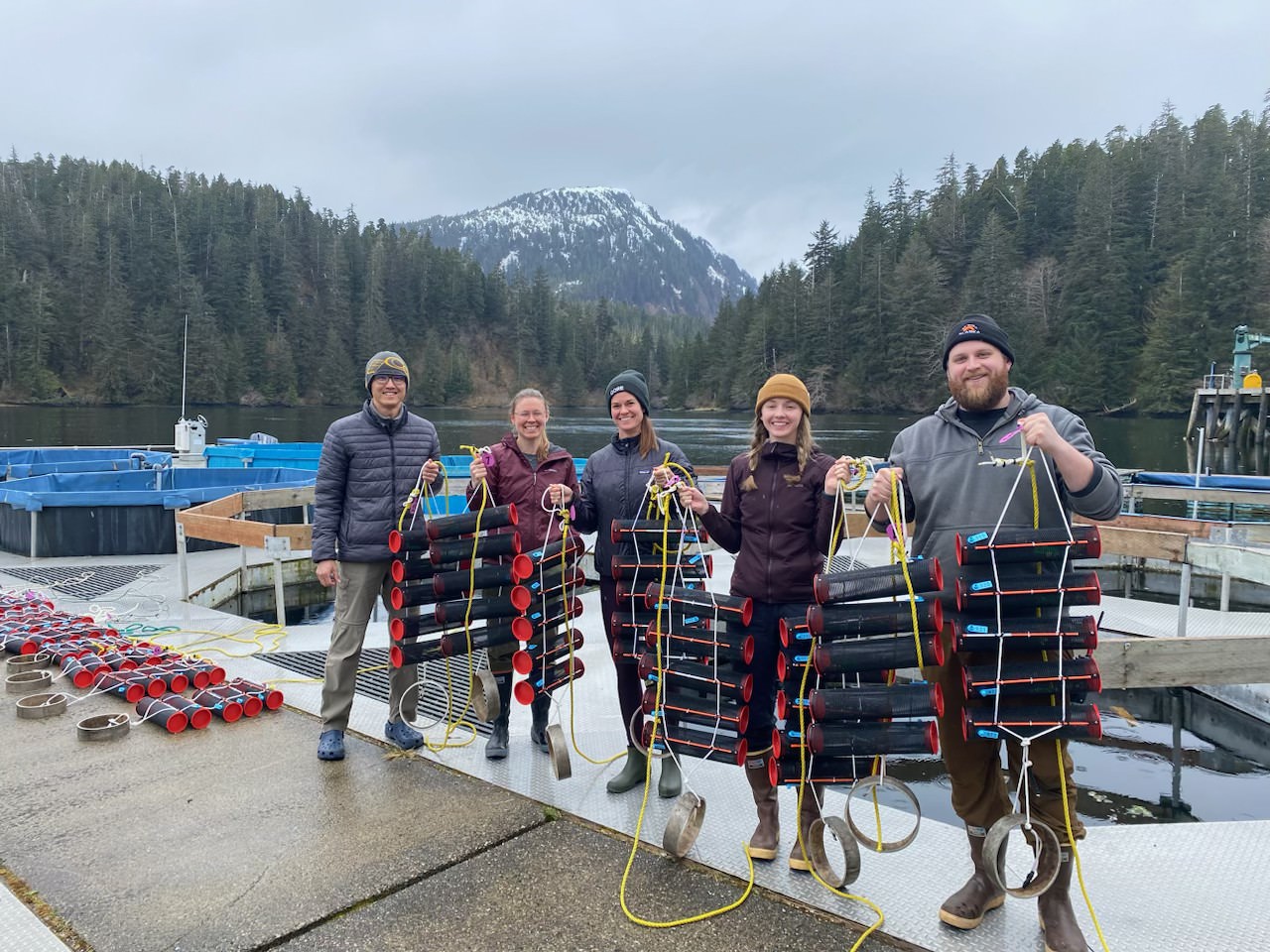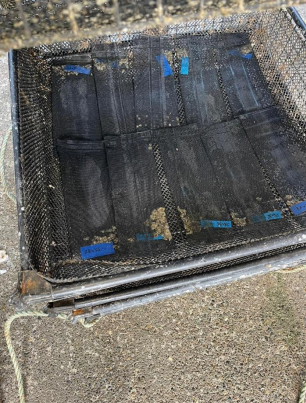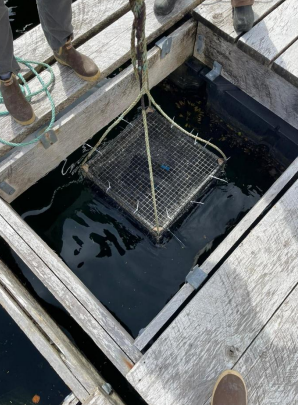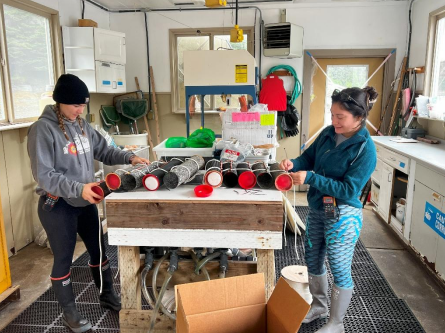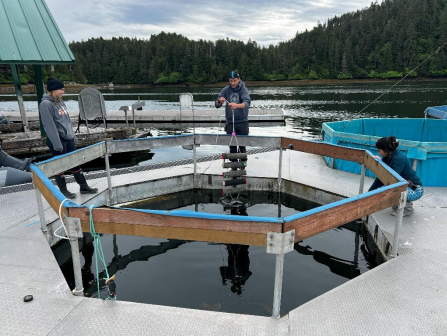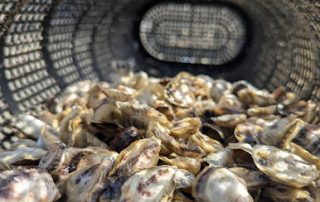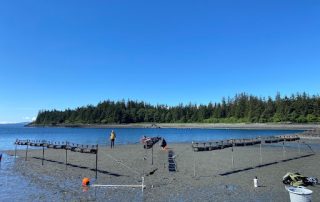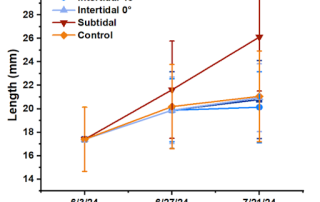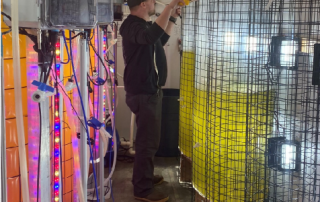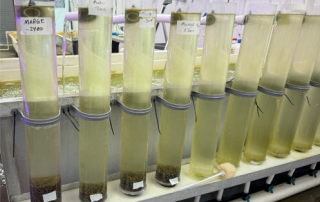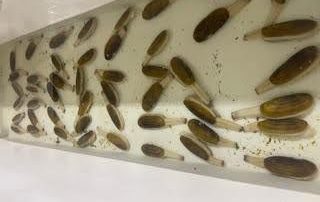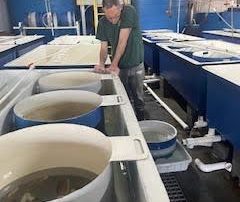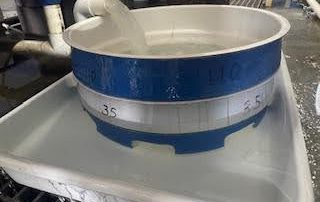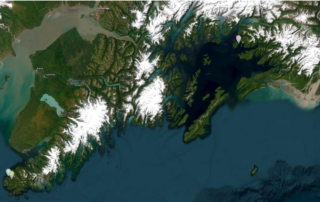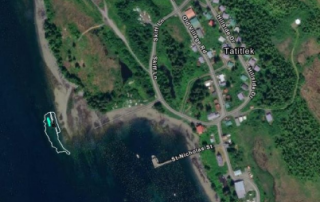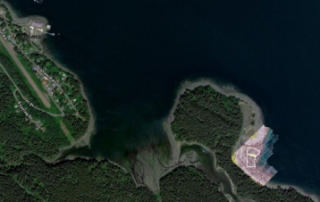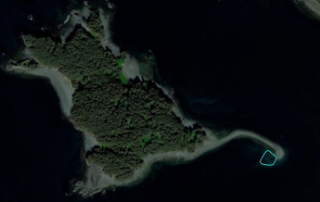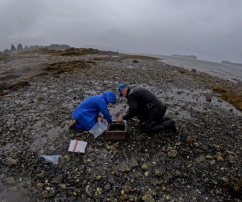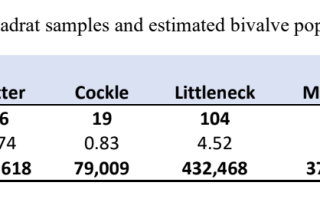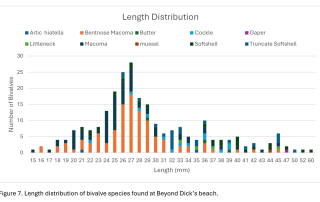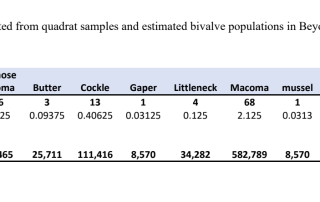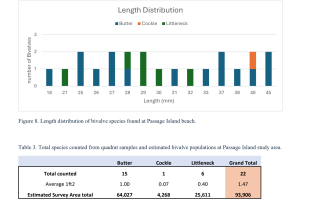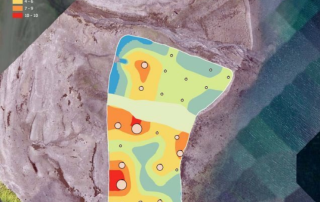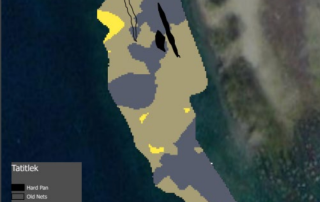Overview
The Joint Innovation Projects (JIP) program is a collection of 29 unique applied research and development projects designed to form strategic private sector partnerships, accelerate innovation, address barriers to growth, and stand up Alaska’s emerging mariculture industry. The JIP program is part of the AMC’s Research & Development grant component and administered by the Alaska Fisheries Development Foundation (AFDF), a subaward recipient.
There are two cohorts of projects. The first JIP cohort was announced in August 2023, and the second JIP cohort was announced in July 2024. Projects were awarded funding through competitive requests for proposals (view JIP RFP #1 here and JIP RFP #2 here). Proposals could only request funding up to $100,000, and each project is funded for a timeline of up to 18-months.
Project findings are to be compiled into reports and distributed to the public, ensuring insights are available to current and future industry participants. This webpage will be updated as interim and final reports are submitted.
Table of Contents
Please use the Table of Contents below to browse all 29 Joint Innovation Projects. Select a category, then click the project numbers to jump ahead.
1. Evaluating Infrastructure and Seeding Methods for Scalable Bull Kelp Cultivation
Lead Entity: Sea Quester Farms
Funding: $98,957.55
Location: Juneau, AK
Start Date: August 1, 2023
End Date: January 31, 2025
JIP Cohort #1: Innovations in Seaweed Farming
Sea Quester Farms is testing new approaches to improve food-grade, commercially viable bull kelp cultivation at their farm near Juneau, Alaska. The project compares growth on two types of arrays—surface arrays tethered at the water’s surface and benthic arrays anchored to the seafloor—while also testing continuous versus interval seed spacing along grow lines. The goal is to better replicate bull kelp’s natural conditions, where it grows in smaller groups on rocks rather than densely on suspended lines, a setup that has caused problems for commercial scaling. Working with the Native Conservancy, Spruce Root, and other Sustainable Southeast Partnership communities, the team will share findings to inform Alaska’s kelp farming practices.
Presentation Videos
Coming Soon
2. Assessing Optimal Infrastructure and Seeding Approaches for Large-Scale Cultivation of Bull Kelp
Lead Entity: Sea Quester Farms
Funding: $100,000
Location: Juneau, AK
Start Date: August 2024
End Date: April 30, 2026
JIP Cohort #2: Innovations in Seaweed Farming
Sea Quester Farms is conducting field trials near Juneau to refine methods for producing food-grade, commercially viable bull kelp. Building on earlier research, the project compares enhanced array designs with different seeding strategies, focusing on how to better replicate kelp’s natural growth on the seafloor, where it occurs in dispersed clusters rather than dense mats. By spacing seeded segments along lines and testing benthic-style arrays tethered to the seafloor, the team aims to improve yields and reduce the costs that have hindered large-scale production. Collaborators include Goldbelt, Spruce Root, Sustainable Southeast Partnership, Ecotrust, and CRTC, who will help share results broadly across the industry.
Interim Update (Pending)
Final Report (Pending)
Presentation Videos
Coming Soon
3. Bull Kelp Buoyancy Assessment
Lead Entity: Native Village of Eyak
Funding: $100,000
Location: Eyak, AK
Start Date: October 2024
End Date: Extended to January 31, 2026
JIP Cohort #1: Innovations in Seaweed Farming
This project addresses a key challenge in kelp farming: the lack of data on how bull kelp buoyancy changes over the growing season, which complicates the design of cost-effective anchoring systems. The study deploys seeded crab pots suspended at 10 m in Prince William Sound, monitoring kelp density, morphology (bulb size, stipe length, biomass), and overall buoyancy, alongside oceanographic data from instruments such as a CTD, temperature loggers, and an acoustic doppler current profiler (ADCP). Early results from the first season show slow kelp growth and declining densities, likely linked to nutrient limitations, as well as biofouling issues. Technical challenges, such as corrosion of stainless-steel mesh, were mitigated by switching to more durable materials. While buoyancy changes have not yet been detected due to small plant size, the study is generating valuable environmental insights into growth conditions and farm infrastructure needs. The team is considering a second growing season to strengthen results, while planning to complete data collection, analysis, and dissemination by the end of the project cycle, with findings expected to guide the engineering of anchoring systems for bull kelp farms.
Final Report (Pending)
Presentation Videos
Coming Soon
4. Building capacity for gametophyte generation and direct seeding techniques for the commercial kelp species Saccharina latissima (Sugar kelp) in Alaska
Lead Entity: Chugach Regional Resources Commission
Funding: $99,875
Location: Seward, AK
Start Date: October 2024
End Date: April 30, 2026
JIP Cohort #2: Innovations in Seaweed Farming
This project is building Alaska’s first commercial-scale capacity for gametophyte seeding of Sugar kelp (Saccharina latissima), a method offering more consistent densities, genetic traceability, and potentially stronger growth than traditional meiospore-based hatchery techniques. The team has established a new gametophyte lab with incubation systems, maintaining cultures from multiple parental groups, clonal male and female stocks, and mixed cultures from Jakalof Bay. Early experiments showed that lower-density gametophyte cultures achieved significantly higher growth rates, though sporophyte reproduction was not observed. The team also developed practical biomass measurement methods and identified density control as a key driver of growth, while technical challenges limited temperature testing in the first phase. Next steps include experiments on reproductive success and direct seeding, supported by the development of a laboratory wave tank and additional incubator space. The project feeds directly into a follow-on Seed Quality Improvement project, which will extend lab research and fund outplant trials. Ultimately, this work will establish Alaska-specific gametophyte protocols, expand seeding capacity, and enable more cost-effective, reliable kelp cultivation statewide.
Final Report (Pending)
Presentation Videos
5. From Hatchery to Harvest: Examining the effects of different hatchery environments throughout the bull kelp lifecycle
Lead Entity: University of Alaska Fairbanks, Dr. Michael Stekoll
Funding: $100,000
Location: Juneau, AK
Start Date: August 2024
End Date: April 30, 2026
JIP Cohort #2: Innovations in Seaweed Farming
This project aims to determine how abiotic hatchery conditions, specifically temperature and light, affect bull kelp growth from the microscopic stage through to farm harvest, while also evaluating cost and energy tradeoffs. Initial hatchery trials showed that high temperatures accelerated early growth but caused juvenile sporophytes to detach before outplanting, while lower temperatures produced steadier growth with less contamination risk. Higher light levels also appeared beneficial, though data analysis is ongoing. Once seeded lines were deployed, almost all bull kelp washed off within a month, preventing harvest-level comparisons. This prompted additional investigations into environmental and hatchery-related causes of seed loss. The team is now testing whether unusual winter conditions (warmer, rainier, cloudier weather in 2024–25) or hatchery practices (low water motion and frequent GeO₂ additions) contributed to poor seed adhesion. Follow-up experiments in Kodiak are underway using varied water velocities and GeO₂ treatments to evaluate adhesion strength. Despite setbacks, early findings suggest lower hatchery temperatures (~5°C) may improve farm yields, though further replication is needed. A no-cost extension is being sought through June 2026 to repeat trials, confirm results, and strengthen conclusions about how hatchery conditions influence farm-scale bull kelp production. If successful, the project will provide kelp farmers with data-driven hatchery protocols to improve survival, yield, and cost-efficiency.
Final Report (Pending)
Presentation Videos
6. Novel Compound Discovery in Newly Domesticated Alaskan Kelp
Lead Entities: Alaska Ocean Farms, Marine Biologics
Funding: $99,875
Location: Kodiak, AK
Start Date: August 2024
End Date: April 30, 2026
JIP Cohort #2: Innovations in Seaweed Farming
This project focuses on unlocking the industrial potential of Alaska’s kelp resources by extracting high-value bioactive compounds such as fucoidan, laminarin, fucoxanthin, and polyphenols from three kelp species in Kodiak. With markets for these compounds collectively valued in the hundreds of millions of dollars globally—driven by demand in dietary supplements, pharmaceuticals, and cosmetics—the initiative aims to demonstrate the feasibility of compound extraction as a pathway to scaling Alaska’s mariculture industry. The project will also assess the variability of fucoidan content across species, since sugar kelp typically contains only 2–3% depending on nutrient conditions, while other kelps may offer higher yields. Outcomes will provide critical data on extraction processes, commercial viability, and species selection, laying the foundation for future industrial-scale biomass processing in remote coastal regions of Alaska.
Interim Update
Interim Presentation Slides
Final Report (Pending)
Presentation Videos
7. Testing Four Approaches to Small-Scale Primary Seaweed Stabilization & Matching Methods to Markets
Lead Entity: Saltwater Inc, Regeneration North
Funding: $99,240
Location: Homer
Start Date: August 1, 2023
End Date: January 31, 2025
JIP Cohort #1: Innovations in Processing
This project explores efficient primary processing methods for kelp at the community hub or small farm collective scale (10–30 acres) to better align production with local infrastructure, products, and markets. Building on prior work and partnerships with APMI, the University of Alaska, and Salmon Sisters, the team has tested stabilization techniques including drying in a modified high tunnel, salting for food preservation, and fermentation to create plant biostimulants. More than 3,000 pounds of kelp were processed, with inputs tracked and samples sent for nutrition and safety testing. Community engagement included tours and workshops with Native communities in Port Graham and Nanwalek, while collaborations with Salmon Sisters expanded value-added sales through retail and e-commerce. All dried kelp was sold, and test batches were run with larger drying systems (Beltomatic) to evaluate scalability. Next steps include trials with an IR dryer, further data analysis, and developing recommendations for scaling small-farm processing. The project is on track, with all funds expected to be used, and demonstrates how diversified stabilization methods can both enable scale-up and open new market opportunities for Alaska’s mariculture industry.
Presentation Videos
8. Pilot scale forced-air drying and milling of farmed kelp – Gateway to mid to large scale drying, qualitative assessment, and development of dried kelp products
Lead Entity: Kodiak Archipelago Leadership Institute
Funding: $53,980
Location: Kodiak
Start Date: December 2023
End Date: January 31, 2025
JIP Cohort #1: Innovations in Processing
This 12-month project tests forced air drying and milling as scalable methods for the primary stabilization of farmed kelp, addressing a critical need for post-harvest processing solutions in Alaska’s coastal communities. Trials are being conducted at the Kodiak Seafood and Marine Science Center (KSMSC), with data collected on drying efficiency, economic feasibility (energy and labor costs), and the quality of dried kelp (nutrient content, heavy metals, microbial levels, water activity). Early progress includes installation of a new dryer and hammer mill, drying ~100 lbs of bull kelp into ~11 lbs of dried product, and preparing samples for nutritional and microbial testing. Budget adjustments are planned to expand testing to additional kelp species (dragon kelp and split kelp), include fertilizer analysis, and trial a pre-drying water reduction step with a pneumatic screw press. Community engagement is central: Alaska Native farmers from Ouzinkie participated in harvests for trials, and outreach is planned through demonstrations, workshops, and a “taste and tell” event at the Kodiak Archipelago Rural Regional Leadership Forum. The project is on track to finish on time and use all funds, with results expected to guide practical small-scale drying and milling systems for kelp farmers across Alaska.
Presentation Videos
Coming Soon
9. Kelp Stabilization for Rural Communities: Designing for Decentralized Processing
Lead Entity: GreenWave
Funding: $94,848
Location: Kodiak, AK
Start Date: August 2023
End Date: January 31, 2025
JIP Cohort #1: Innovations in Processing
This project tackles the challenge of kelp’s rapid post-harvest degradation by developing an open-source, low-tech processing line that can stabilize seaweed at ambient temperature close to farms, enabling rural producers to extend shelf life and access markets. The centerpiece is the Vincent VS-8 shredder, chosen for its affordability, durability, compact design, and ability to process whole kelp with minimal labor and power. Equipment was procured, tested, and commissioned at the Kodiak Seafood and Marine Science Center (KSMSC), where the team hosted a demonstration for 17 attendees (including Indigenous participants) and processed over 5,000 lbs of kelp from Alaska Ocean Farms, later sold to Macro Oceans. While some first-year Alaska Native farmers in Kodiak were unable to participate due to permit delays, the project remains on track. Deliverables will include a demonstration video, a full handbook (with bill of materials, drawings, SOPs), a webinar, and a final report disseminated through Sea Grant, GreenWave, and other networks. The initiative highlights a scalable, community-level solution for rural kelp farms, with all outcomes designed to be open-source and widely accessible.
Presentations Videos
10. Evaluate Marketability and Production Protocols for Kelp Based Wine and Spirits
Lead Entity: Float Camp
Funding: $86,050
Location: Ketchikan
Start Date: August 2023
End Date: January 31, 2025
JIP Cohort #1: Innovations in Processing
This project explores the feasibility of producing and marketing kelp-based alcoholic beverages, including wines and spirits, as a new value-added market for Alaska’s mariculture industry. Early trials showed promise in fermentation, leading to approval by the Alcohol and Tobacco Tax and Trade Bureau (TTB) for commercial use. A local distillery successfully scaled the process, producing a smooth vodka-like spirit, with ongoing trials for kelp gin. In contrast, kelp wines were described by consultants as having strong “marine” flavors, with limited appeal as a drinking wine but possible niche use in gourmet cooking. Marketing research, including a dockside cruise ship survey, revealed strong interest in kelp spirits, consumer openness to lighter-weight packaging, and national trends favoring lower-alcohol beverages, suggesting opportunities for canned kelp-based cocktails. Next steps include heavy metal testing, additional distillery runs, completion of the cruise ship and national marketing studies, and final consultant recommendations. Proof of concept has been achieved, with estimates that even a small distillery could use 60,000 pounds of kelp annually. The project concludes that spirits, not wines, represent the strongest commercial opportunity, and results—including recipes—will be shared publicly in 2025 to encourage adoption by Alaskan distilleries.
Presentation Videos
11. Evaluating and Sharing Methods to Efficiently Dry Kelp for Rural Communities
Lead Entity: Barnacle Foods
Funding: $82,131
Location: Juneau
Start Date: August 2023
End Date: January 31, 2025
JIP Cohort #1: Innovations in Processing
This project addresses the challenge of kelp stabilization in rural Alaska, where high energy costs, limited labor, and distance to markets hinder farmers from selling dried kelp—the most common global form of seaweed trade. The goal is to identify and test cost-effective drying methods suited for small-scale farms and community-level processing, producing public reports on equipment, costs, and feasibility. Progress to date includes compiling a global kelp drying report that summarizes methods, costs, and supplier contacts, helping farmers independently evaluate options. Early testing with screw presses showed that mechanical dewatering is not practical for producing dried kelp. Challenges included shipping costs and limited local access to large equipment. Next steps will involve testing other small-scale dryers, measuring electrical consumption, and evaluating two-stage drying (stabilizing kelp below 0.8 water activity before shipping for final processing). By producing open-source guidance on practical drying systems, the project lowers barriers for rural and Alaska Native farmers to enter kelp markets and scale their operations.
Presentation Videos
12. Primary Stabilization of Seaweed Through Drying Technique
Lead Entity: Blue Evolution
Funding: $96,350
Location: Kodiak, AK
Start Date: April 2024
End Date: Extended to January 2026
JIP Cohort #1: Innovations in Processing
Blue Evolution, drawing on its large-scale seaweed processing experience in Baja California, is partnering with Sun’Aq Tribal Enterprises to tackle one of Alaska’s biggest mariculture barriers: cost-effective kelp stabilization. While the project set out to optimize drying conditions and product specifications for market entry, it has also advanced an alternative approach using food-grade acids and preservatives to create shelf-stable kelp that can be stored at room temperature for more than 60 days at a cost of less than one cent per pound. Trials with five acid blends, tested on both Maine and Kodiak sugar kelp, produced multiple recipes that passed microbial testing, with ongoing analysis for heavy metals, carbon:nitrogen ratios, iodine content, and taste. By combining drying expertise with low-cost preservation methods, the project aims to deliver scalable, easy-to-use stabilization techniques that rural and Alaska Native harvesters can adopt with standard harbor equipment, strengthening Kodiak’s economy and making Alaska’s kelp industry more competitive globally.
Final Report (Pending)
Presentation Videos
Coming Soon
13. Building a product bridge: Cost-effective primary stabilization for transportation of Alaska kelp to market
Lead Entity: Atlantic Sea Farms
Funding: $94,598
Location: Kodiak, AK
Start Date: September 2023
End Date: January 31, 2025
JIP Cohort #1: Innovations in Processing
This project is developing a low-cost, shelf-stable preservation method for kelp using USDA-approved food-grade acids and preservatives, aiming to eliminate the need for freezing or drying, which are expensive and limit market access. By creating a bulk product that can be stored at room temperature for over 60 days, the approach could reduce shipping costs by more than 40% compared to frozen kelp and supply buyers like Atlantic Sea Farms, which is interested in purchasing over 200,000 pounds annually. Trials with five acid-preservative blends have identified multiple recipes that maintained kelp stability through microbial testing and taste panel evaluations, with additional analysis underway for heavy metals, carbon : nitrogen ratios, and iodine content. The project will conclude with a cost analysis and practical instructions enabling kelp harvesters to replicate the process using common harbor or community equipment, positioning Alaska’s farmers to compete more effectively in global seaweed markets.
Presentation Videos
14. Building a shipping route: Cost-reducing methods to transport stabilized kelp from Alaska to market
Lead Entity: Atlantic Sea Farms
Funding: $99,929
Location: Kodiak, AK
Start Date: September 2024
End Date: April 30, 2026
JIP Cohort #2: Innovations in Processing
Building on earlier trials that proved kelp can be stabilized in low-cost brine solutions without freezing or cold storage, Atlantic Sea Farms is leading this Phase 2 project to address the remaining barrier: economically viable transport of Alaska-grown kelp to markets in the Lower 48. The work will test dewatering equipment to reduce water content after stabilization, trial a small-scale dehydrator suitable for rural use, and evaluate how these steps affect kelp composition and end-use quality. The project will conclude with a public economic analysis outlining the commercial potential of these methods, aiming to cut transportation costs and open new market opportunities for Alaska’s kelp farmers.
Interim Update (Pending)
Final Report (Pending)
Presentation Videos
Coming Soon
15. Mobile Seaweed Processing
Lead Entity: Mothers of Millions
Funding: $100,000
Location: Prince William Sound, AK
Start Date: August 2024
End Date: April 30, 2026
JIP Cohort #2: Innovations in Processing
Mothers of Millions (MOM) is developing a mobile, organic-certified seaweed harvesting and processing platform to help farmers in Southcentral Alaska overcome logistical and economic barriers in bringing kelp from remote farms to market. During the 2025 harvest season, MOM processed kelp from multiple farms in Prince William Sound and Southeast Alaska, shifting from freezing kelp to stabilizing it for agricultural markets to build stronger ties with new buyers. The project demonstrated that kelp yields can vary widely across farms and years, requiring flexible processing approaches, while also advancing organic certification: all partner farms submitted paperwork and completed inspections, with certifications expected by fall 2025. Next steps include completing a final report and refining the mobile platform to expand its reach for future harvests, supporting scalable, on-water processing solutions that strengthen Alaska’s mariculture industry.
Final Report (Pending)
Presentation Videos
16. Reducing Impact of Iodine & Heavy Metals in Seaweed to address Barriers of Growth
Lead Entities: Four Corner Foods, Wildsource
Funding: $99,530
Location: Kodiak, AK
Start Date: August 2024
End Date: April 30, 2026
JIP Cohort #2: Innovations in Processing
This project addresses a key food safety barrier to seaweed consumption: the presence of heavy metals and high iodine levels that limit daily intake recommendations. Four Corner Foods is testing hot water and live steam blanching methods on Kombu, Wakame, and Bull kelp to reduce these compounds and improve marketability. Initial trials showed significant reductions in heavy metals and iodine, though some anomalies were noted in lab results, and sourcing kelp for testing proved challenging. Next steps include pairing blanching with dehydration, quantifying safe consumption levels under FDA and Prop 65 standards, and issuing a final report with best-practice recommendations. If successful, the project will provide processors with scalable pre-processing methods to produce safer, more market-ready kelp products.
Final Report (Pending)
Presentation Videos
17. Solar Drying of Alaskan Seaweed and Use as a Sustainably Sourced Layer Hen Feed Ingredient
Lead Entities: Premium Aquatics, Word Wildlife Fund, Wilcox Farms
Funding: $99,625
Location: Prince of Wales Island & University of Arizona
Start Date: August 2024
End Date: April 30, 2026
JIP Cohort #2: Innovations in Processing
This project tests the suitability of Alaska-farmed sugar kelp (Saccharina latissima) as an ingredient in certified organic poultry feed, aiming to expand markets for harvested kelp. Using an innovative solar tower drying system to preserve nutrients and stabilize kelp for transport, dried kelp will be incorporated into layer hen diets at 3–5% for 6–8 weeks and compared to conventional diets. Researchers will measure bird intake, digestion, fecal microbiome, and egg production traits including size, weight, shell strength, yolk color, and nutritional content, while also tracking nutrient stability, microbial loads, and economic and environmental impacts. Results will be shared through conferences, peer-reviewed publications, and outreach to Alaska farmers, Native groups, and mariculture stakeholders, highlighting kelp’s potential as a sustainable feed additive.
Interim Report Presentation Slides
Final Report (Pending)
Presentation Videos
18. Expanding Markets through Differentiation: New Species and Product Lines
Lead Entities: Saltwater Inc, Regeneration North
Funding: $99,625
Location: Anchorage, AK
Start Date: September 2024
End Date: April 30, 2026
JIP Cohort #2: Innovations in Processing
This project addresses the imbalance between Alaska’s growing supply of farmed sugar kelp and current market demand by focusing on species diversification, product differentiation, and market expansion. Building on lessons from earlier stabilization and processing trials, the work supports four farms and two nurseries in cultivating three additional kelp species, expands salting trials and product testing for gourmet and specialty food markets, and develops seaweed-based plant biostimulants for Alaska growers. By linking farming and processing innovations with differentiated products and diverse markets, the project aims to strengthen the value chain and accelerate the development of a resilient Alaska seaweed industry.
Interim Report Presentation Slides
Final Report (Pending)
Presentation Videos
19. Simulation and Development of a Kelp Drying Prototype Using Existing Equipment
Lead Entity: Sea Quester Farms
Funding: $67,429
Location: Juneau, AK
Start Date: October 2024
End Date: April 30, 2026
JIP Cohort #2: Innovations in Processing
This project tackles the challenge of drying and storing bull kelp, which is limited by its high moisture content and the cost or inaccessibility of conventional drying equipment. Sea Quester Farms is developing a container-based prototype that repurposes a freezer unit retrofitted with a heat pump to capture waste heat from adjacent storage systems, enabling efficient, low-cost drying with equipment already common in Southeast Alaska. The approach aims to improve the economic viability of kelp producers, expand access to larger kelp markets, and strengthen the region’s capacity to meet rising global demand. Findings will be shared broadly with partners, including Spruce Root, to promote adoption of scalable, sustainable drying practices across the mariculture sector.
Interim Update (Pending)
Final Report (Pending)
Presentation Videos
Coming Soon
20. Helical Anchor Performance Analysis
Lead Entities: Anchorbot, Premium Aquatics
Funding: $59,640
Location: Craig, AK
Start Date: September 2023
End Date: January 31, 2025
JIP Cohort #1: Innovations in Mooring Systems
Anchoring is one of the most expensive and prohibitive costs for aquaculture farms, often limiting new operations from expanding. This project evaluates helical anchors as a more affordable, high-performance, and environmentally friendly solution for securing aquaculture installations in Alaska’s challenging marine environments. The objective is to comprehensively test how these anchors perform under different bottom types and conditions, and determine their overall suitability for mariculture farms. Field work is centered around Seagrove’s Doyle Bay and Real Marina lease sites near Craig, Alaska. Doyle Bay is a 127-acre tideland lease with varied subsurface substrates, including mud, silt, clay, gravel, and rock, while Real Marina is a 132-acre lease with silt, clay, mud, and rock substrates. A third location at Madre de Dios is also under evaluation. Core sampling equipment has been deployed at all three sites, confirming the presence of a range of sediments suitable for anchor testing. To prepare for trials, Anchorbot (formerly Holdfast Robotics) has developed a specialized anchor installation vehicle and operational hardware to place and measure anchor performance. A local fishing vessel owner has been contracted to support installation and retrieval operations, scheduled for September 2024 after the fishing season. Anchors will be installed and pulled to measure holding power, installation efficiency, and compatibility with different substrates. Immediately following installation, the project team will analyze data on performance by sediment type and location, while documenting lessons learned from the operational process. Select anchors will also be left in place to monitor long-term durability and performance, providing critical insights for future farm infrastructure. This work will directly inform best practices for the Alaska mariculture industry, reducing farm costs and helping scale up operations sustainably.
Presentation Videos
21. Sea Otter Sound Mariculture Data Initiative: Collaborative Monitoring and Innovation in Southeast Alaska’s Mariculture Industry
Lead Entities: Kelp Blue, Craig Tribal Assocation
Funding: $100,000
Location: Prince of Wales, AK
Start Date: August 2024
End Date: April 30, 2026
JIP Cohort #2: De-risking Farming Through Site Suitability Analysis
The Sea Otter Sound Mariculture Data Initiative is designed to strengthen sustainable mariculture in Southeast Alaska through comprehensive site monitoring and environmental data collection. At its core, the project conducts bi-weekly and post-storm environmental surveys at a mariculture lease in Sea Otter Sound, paired with continuous real-time data from a Sofar Spotter Buoy tracking wave and climate conditions. These efforts are complemented by mapping of native giant kelp forests using the Mapping Canopy-Forming Kelps guidebook. The initiative has several key objectives: to evaluate site suitability for giant kelp farming, optimize mooring system design and placement, and monitor overall ocean health and marine mammal activity, including endangered species. The project is advancing solutions that demonstrate approaches for year-round farming in Alaska’s dynamic marine environment. Findings will be broadly shared with industry stakeholders, regulators, and community partners to guide informed decision-making, ecological stewardship, and technology adoption. By integrating farm operations with long-term environmental monitoring, the initiative aims to set a new standard for sustainable kelp farming in Alaska while contributing to the resilience and credibility of the state’s mariculture industry.
Final Report (Pending)
Presentation Videos
Coming Soon
22. Early Warning of Harmful Algal Blooms and Biofouling Larvae Using the PlanktoScope, A Low-Cost Automated Plankton Imaging and Analysis Tool
Lead Entity: Ostrea Marine
Funding: $75,727
Location: Juneau, AK
Start Date: September 2024
End Date: April 30, 2026
JIP Cohort #2: De-risking Farming Through Site Suitability Analysis
Harmful algal blooms (HABs) and biofouling organisms pose serious risks to Alaska’s shellfish farmers and subsistence harvesters, threatening both human health and farm economics. When biotoxin levels exceed regulatory limits, farms may be shut down for weeks or months, while biofouling larvae like mussels and barnacles settle on gear, adding costs and reducing yields. Predicting and monitoring these events is extremely challenging given Alaska’s vast, complex coastline, and existing monitoring tools are often too expensive or labor-intensive for small-scale farms. This project is piloting the PlanktoScope, an open-source, low-cost (<$5,000) digital microscopy platform that images and identifies plankton in near real time. By adapting this tool for Alaskan conditions, the project aims to provide shellfish farmers and harvesters with early warning of HAB events and biofouling activity, enabling proactive management and mitigation measures. If successful, the approach could dramatically lower barriers to bloom monitoring, safeguard public health, and reduce costly disruptions to farm operations—helping shellfish growers remain resilient and competitive.
Final Report (Pending)
Presentation Videos
Coming Soon
23. Developing improved seed of the Pacific oyster for the Southeast Alaska regions
Lead Entity: Pacific Hybreed, NOAA Fisheries
Funding: $90,723
Location: Juneau, AK
Start Date: August 1, 2023
End Date: January 31, 2025
JIP Cohort #1: Boosting Oyster Growth at Nurseries or Farms
Alaska’s oyster farms currently rely on seed from West Coast hatcheries that are optimized for lower-latitude waters, resulting in slow growth and high juvenile mortality in Alaska’s colder conditions. This project is establishing the state’s first selective breeding program for Pacific oysters (Crassostrea gigas) tailored to Alaska’s environments. Researchers are conducting controlled genetic crosses at the Pacific Hybreed hatchery, producing within-species hybrids from pedigreed lines and confirming them through molecular genotyping. In collaboration with NOAA scientists, seed from 23 hybrid oyster families were deployed in 92 replicated cages at the Little Port Walter Research Station, where growth and survival are being tracked alongside environmental data to develop physiological growth models. Early results are expected to identify the most promising crosses for consistent reproduction and inclusion in a breeding program based in Alaska. These efforts will provide the foundation for Alaska-optimized broodstock that can supply hatcheries and farms with improved oyster seed, supporting faster growth, higher survival rates, and long-term industry viability. Future phases will expand testing to commercial farms, comparing new genetic lines against current seed sources to refine the selection process.
Presentation Videos
Coming Soon
24. Developing Hybrid Oyster Seeds for Alaska Shellfish Growers
Lead Entities: Pacific Hybreed, NOAA Fisheries
Funding: $100,000
Location: Juneau, AK
Start Date: August 2024
End Date: April 30, 2026
JIP Cohort #2: Boosting Oyster Growth at Nurseries or Farms
This project expands on earlier breeding work (JIP #23) by producing and evaluating elite hybrid oyster families specifically suited to Alaska’s colder growing conditions. Pacific Hybreed researchers are leveraging their long-term broodstock repository and genotyped adult oysters from multiple genetic lines to create both single-hybrids (best-performing first-generation crosses) and double-hybrids (crosses of unrelated elite hybrids known for superior performance and resilience). So far, researchers have successfully conducted full diallel crosses, generating 25 hybrid and 5 purebred lines. Juveniles were subdivided into replicates, measured for size and weight, and deployed at NOAA’s Little Port Walter Biological Research Station and Seagrove Oysters for field evaluation. These trials run in parallel with monitoring of families produced during the previous JIP cycle, creating a multi-year dataset on oyster growth and survival in cold-water environments. Next steps include analyzing summer growth and survival data, selecting top-performing families, and advancing them toward commercial seed production. By identifying and propagating the most resilient and productive genetic lines, the project aims to provide Alaskan farms with locally optimized oyster seed, improving consistency, survival, and industry profitability.
Final Report (Pending)
Presentation Videos
25. Optimizing the tumble culture method to improve Pacific Oyster quality, and reduce labor for shellfish farms in Southeast Alaska
Lead Entity: Ostrea Marine
Funding: $100,000
Location: Juneau, AK
Start Date: July 2023
End Date: Extended to January 31, 2026
JIP Cohort #1: Boosting Oyster Growth at Nurseries or Farms
This project is testing whether tumble cage culture, widely used elsewhere to improve oyster shape, size, and yield, can be adapted to Alaska’s challenging conditions. Tumble cages use tidal and wave energy to gently mix oysters, reducing labor, discouraging predators like sea stars, and improving shell quality without mechanical tumblers. However, prior Alaska trials failed due to “over-tumbling,” which damaged oysters and gear. To address this, the project team—including engineers, biologists, and oyster farmers—designed custom Alaska-specific cage mounts that dampen and fine-tune cage motion, making the system more resilient in rough waters. As of spring 2024, nine cage arrays with 60 tumble cages and over 45,000 oysters were deployed at partner farms Salt Lady and Hump Island. Arrays include cages equipped with temperature loggers and accelerometers, alongside control cages to compare growth, morphology, and biofouling against standard culture methods. Early subsampling began in June and July, with growth, morphology, and environmental data under analysis. While logistical issues prevented deployment at Kawuu Oyster Company, plans are underway to establish a version 2 research farm in Hoonah. The project also emphasizes workforce development: Ostrea Marine partnered with the Tlingit and Haida Youth Employment Services program, hosting a local youth trainee, and supported a NOAA Hollings Scholar whose senior thesis will be based on project data. By trialing gear across diverse farm conditions, the initiative will produce best-practice recommendations on tumble culture’s viability in Alaska, with the potential to significantly reduce labor costs and improve oyster production outcomes.
Final Report (Pending)
Thesis Paper
Presentation Videos
Coming Soon
26. Design and comprehensive planning of an Alaskan optimized intermodal freight container based shellfish setting and pre-nursery seed boosting system
Lead Entity: OceansAlaska
Funding: $89,9650
Location: Ketchikan, AK
Start Date: August 2023
End Date: January 31, 2025
JIP Cohort #1: Boosting Oyster Growth at Nurseries or Farms
Alaska’s oyster industry faces a major bottleneck: commercial hatcheries in Washington and Hawaii typically supply small seed (~2–3 mm) optimized for warmer waters, but Alaska’s short, cold growing season requires +4 mm seed to achieve strong survival and faster growth in FLUPSY systems. Because larger seed is rarely available at the right time of year, Alaskan farmers lose valuable growing months and profitability. This project is designing a containerized pre-nursery system to locally condition oyster seed to larger sizes while producing algae feed and maintaining heated seawater. Container-based units are modular, energy-efficient, and can be shipped by barge, then deployed in remote communities to match local labor and infrastructure capacities. Initial concepts with large weller tanks proved too costly and difficult to heat, so the team adapted the design into a compact, bottle-based nursery system with a heat pump that recaptures energy from hatchery outflows. This revised design maximizes space efficiency and reduces energy needs while prioritizing algae production to support robust seed growth. Next steps include developing professional engineering drawings, detailing equipment and material requirements, and producing a comprehensive design and cost report. The system will be field-evaluated on Prince of Wales Island and Metlakatla. By providing farmers with consistent access to +4 mm oyster seed, this project could transform production efficiency and help build a more resilient Alaska oyster industry.
Presentation Videos
Coming Soon
27. Hatchery Cultivation of the pacific razor clam (Siliqua patula)
Lead Entity: Chugach Regional Resources Commission
Funding: $83,000
Location: Seward, AK
Start Date: August 2023
End Date: January 31, 2025
JIP Cohort #1: Shellfish Enhancement
This project seeks to develop reliable hatchery and nursery methods for razor clams, a once-abundant species in Alaska that has declined sharply in the wild and lacks a hatchery seed source. Building on earlier work at APMI and UAF, the project is focused on broodstock conditioning, larval rearing at commercial densities, and nursery grow-out procedures that could eventually support both restoration and commercial farming. Broodstock collection efforts in Prince William Sound produced only 20 clams with no successful spawns, while collections in Lower Cook Inlet yielded more promising results. From 105 clams collected, two successful spawning events were achieved, producing an estimated 400,000 juveniles averaging 1.2 mm. Several challenges emerged, including high mortality of broodstock during transport and culture, limited numbers of viable females, and variability in egg fertilization success. Nonetheless, one combined spawn was successfully reared through a 19-day larval stage to settlement, with approximately 275,000 juveniles surviving to be transferred into sand-based settling bins for further grow-out. With refinement of broodstock handling, spawning, and larval care, the project aims to generate repeatable protocols and establish Alaska’s first consistent source of razor clam seed. If successful, this effort could provide new opportunities for shellfish farmers and support ecological restoration where razor clam populations have collapsed.
Presentation Videos
Coming Soon
28. Evaluating subsistence shellfish beaches for future enhancement projects
Lead Entity: Chugach Regional Resources Commission (CRRC)
Funding: $28,350
Location: Seward, AK
Start Date: August 2023
End Date: January 31, 2025
JIP Cohort #1: Shellfish Enhancement
In the 1990s, the CRRC conducted extensive surveys of subsistence shellfish beaches with support from the Exxon Valdez Oil Spill Project, identifying habitat conditions and seeding beaches with clams and cockles. Only a few sites—near Tatitlek, Port Graham, and Chenega—showed long-term promise. With new seeding techniques and predator control strategies available, this project revisits those same beaches to determine whether they remain suitable for shellfish enhancement. In summer 2023, APMI and PSI researchers surveyed three historically important beaches—Tatitlek, Beyond Dick’s (near Port Graham and Nanwalek), and Passage Island. Each site was systematically flagged, mapped, and sampled using randomized quadrat sampling to quantify shellfish populations, while sediment cores and GPS-referenced data were collected to assess habitat suitability. Drones were also used to capture aerial images where weather allowed. In total, 23 quadrats were sampled at Tatitlek, 32 at Beyond Dick’s, and 25 at Passage Island, covering intertidal areas between -2 and +2 tide levels. The data are now being used to generate GIS-based population density and habitat maps for each site, which will be shared with tribal communities as tools for conservation planning and sustainable harvest management. By revisiting and updating these surveys with modern technology, the project lays the groundwork for future outplant and enhancement efforts, ensuring that culturally important shellfish resources can be restored and sustained for local communities.
Final Report (Pending)
Presentation Videos
Coming Soon
29. Developing increased survival techniques for shellfish enhancement of two species (Clinocardium nuttallii and Mya arenaria) through implementing predator protection in Southeast Alaska
Lead Entity: Organized Village of Kake
Funding: $97,725
Location: Kake, AK
Start Date: August 2024
End Date: April 30, 2026
JIP Cohort #2: Shellfish Enhancement
With sea otter populations increasing across Southeast Alaska, subsistence communities face major challenges maintaining access to shellfish resources such as cockles and soft-shell clams. This project is testing predator control blankets as a grow-out technique to improve shellfish survival and growth on subsistence beaches near Kake. The work builds on a local pilot study where the Organized Village of Kake successfully conducted two rounds of cockle out-planting. The project’s objectives are threefold: (1) collaborate with hatcheries refining methods for producing strong seed for cockles and soft-shell clams; (2) evaluate best practices for installing and maintaining predator control blankets to protect seeded plots; and (3) carry out a 12-month grow-out trial across four controlled scenarios to measure growth, survival, and predator interactions. The initiative also prioritizes community engagement. Four events will be held with Kake residents to involve them directly in pre-surveys of the beaches, out-planting activities, ongoing monitoring, and post-study evaluations. By combining innovative predator control technology with deep community participation, this project seeks to create a replicable model for protecting shellfish resources critical to food security, cultural practices, and subsistence economies in Southeast Alaska.
Interim Update (Pending)
Final Report (Pending)
Presentation Videos

